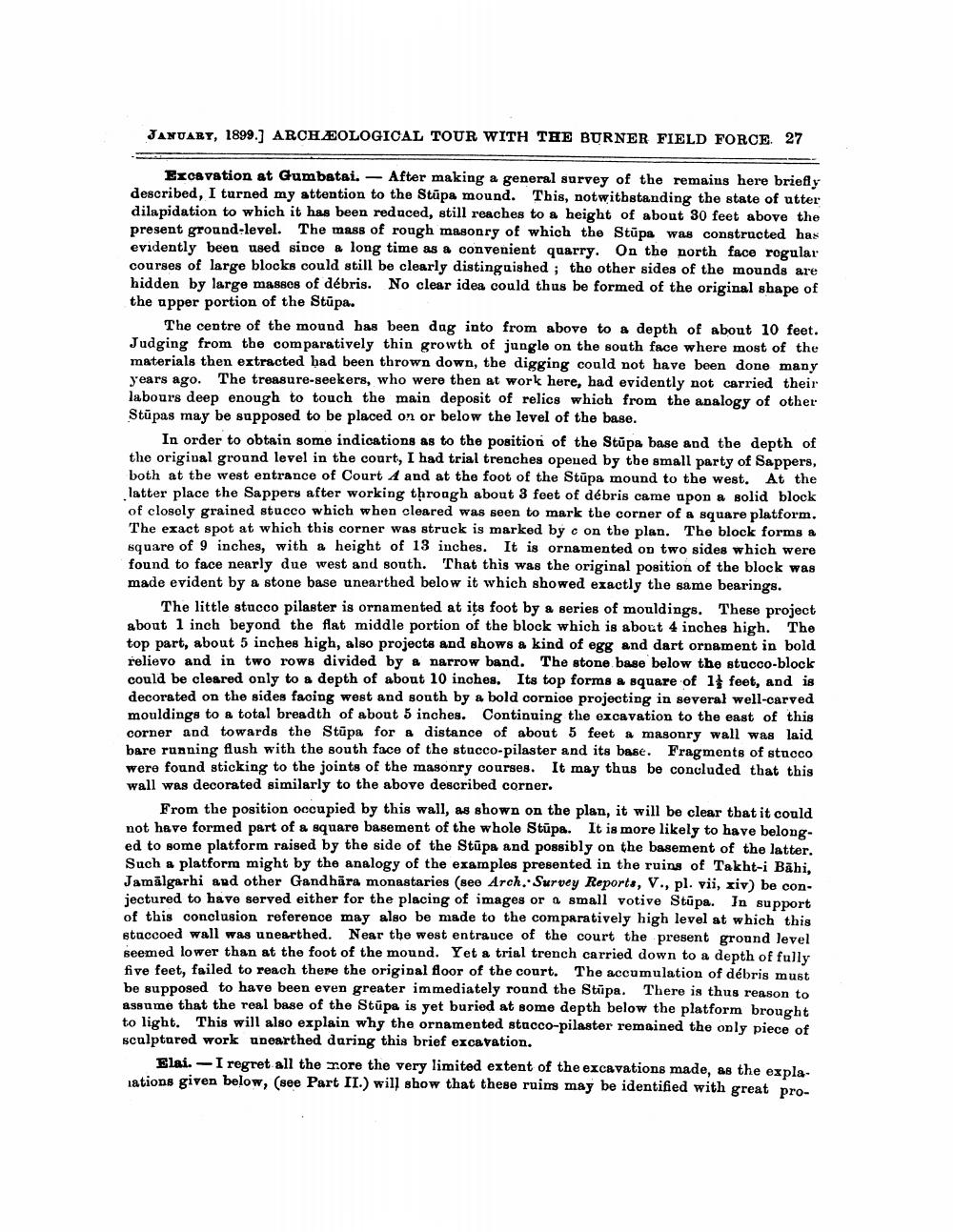________________
JANUARY, 1899.] ARCHEOLOGICAL TOUR WITH THE BURNER FIELD FORCE. 27
Excavation at Gumbatai.
-
- After making a general survey of the remains here briefly described, I turned my attention to the Stupa mound. This, notwithstanding the state of utter dilapidation to which it has been reduced, still reaches to a height of about 30 feet above the present ground-level. The mass of rough masonry of which the Stupa was constructed has evidently been used since a long time as a convenient quarry. On the north face regular courses of large blocks could still be clearly distinguished; the other sides of the mounds are hidden by large masses of débris. No clear idea could thus be formed of the original shape of the upper portion of the Stupa.
The centre of the mound has been dag into from above to a depth of about 10 feet. Judging from the comparatively thin growth of jungle on the south face where most of the materials then extracted had been thrown down, the digging could not have been done many years ago. The treasure-seekers, who were then at work here, had evidently not carried their labours deep enough to touch the main deposit of relics which from the analogy of other Stūpas may be supposed to be placed on or below the level of the base.
In order to obtain some indications as to the position of the Stupa base and the depth of the original ground level in the court, I had trial trenches opened by the small party of Sappers, both at the west entrance of Court 4 and at the foot of the Stupa mound to the west. At the latter place the Sappers after working through about 3 feet of débris came upon a solid block of closely grained stucco which when cleared was seen to mark the corner of a square platform. The exact spot at which this corner was struck is marked by e on the plan. The block forms a square of 9 inches, with a height of 13 inches. It is ornamented on two sides which were found to face nearly due west and south. That this was the original position of the block was made evident by a stone base unearthed below it which showed exactly the same bearings.
The little stucco pilaster is ornamented at its foot by a series of mouldings. These project about 1 inch beyond the flat middle portion of the block which is about 4 inches high. The top part, about 5 inches high, also projects and shows a kind of egg and dart ornament in bold relievo and in two rows divided by a narrow band. The stone base below the stucco-block could be cleared only to a depth of about 10 inches. Its top forms a square of 1 feet, and is decorated on the sides facing west and south by a bold cornice projecting in several well-carved mouldings to a total breadth of about 5 inches. Continuing the excavation to the east of this corner and towards the Stupa for a distance of about 5 feet a masonry wall was laid bare running flush with the south face of the stucco-pilaster and its base. Fragments of stucco were found sticking to the joints of the masonry courses. It may thus be concluded that this wall was decorated similarly to the above described corner.
From the position occupied by this wall, as shown on the plan, it will be clear that it could not have formed part of a square basement of the whole Stupa. It is more likely to have belonged to some platform raised by the side of the Stupa and possibly on the basement of the latter. Such a platform might by the analogy of the examples presented in the ruins of Takht-i Bahi, Jamalgarhi and other Gandhara monastaries (see Arch. Survey Reports, V., pl. vii, xiv) be conjectured to have served either for the placing of images or a small votive Stupa. In support of this conclusion reference may also be made to the comparatively high level at which this stuccoed wall was unearthed. Near the west entrance of the court the present ground level seemed lower than at the foot of the mound. Yet a trial trench carried down to a depth of fully five feet, failed to reach there the original floor of the court. The accumulation of débris must be supposed to have been even greater immediately round the Stupa. There is thus reason to assume that the real base of the Stupa is yet buried at some depth below the platform brought to light. This will also explain why the ornamented stucco-pilaster remained the only piece of sculptured work unearthed during this brief excavation.
Elai. I regret all the more the very limited extent of the excavations made, as the explaiations given below, (see Part II.) will show that these ruins may be identified with great pro




